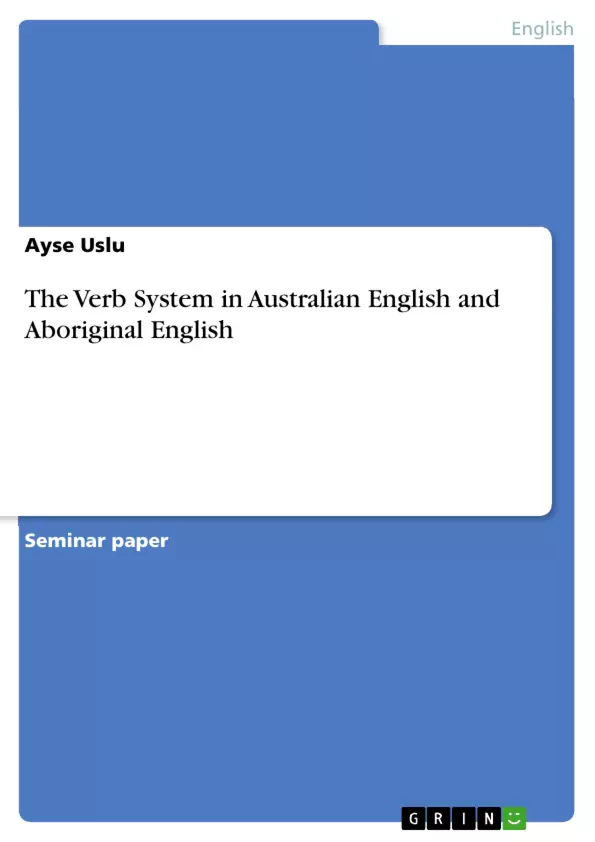In this term paper, the main question that arises is “What are the forms and functions of the verb system in Aboriginal English and Australian English?”. Thus, studies about verb usages of both varieties of English will be analysed, providing an illustration of differences in both systems.
Before dealing with these data in detail, one theory concerning World Englishes and their emergence will be presented in chapter 2.1. One of the theoretical approaches was made by Edgar W. Schneider. His theory is called “The Dynamic Model of New Englishes.” References of this theory that are utilized in this term paper are “The dynamics of New Englishes; From identity construction to dialect birth” (2003) and “Postcolonial English. Varieties around the World” (2007). An explanation of historical, sociolinguistic and linguistic processes leading towards the emergence of New Englishes will thus be given.
Secondly, the Verb system will be illustrated in 2.2., giving an overview of how certain verb structures are used by speakers of English. Before dealing with the analysis of examples of both varieties, the sociolinguistic background of both Australian English and Aboriginal English will be taken into account in chapter 3.1. In this part, the question arises where these varieties are spoken and who acquired and speaks them. Moreover, the history of Aboriginal English and Australian English will be explained. The data analysis in chapter 3.2. shows studies and examples of both varieties. Examples made by Ian G. Malcolm, Peter Collins and Pam Peters are mostly significant. Last but not least, a discussion at the end of the term paper will be added. This shall give readers a conclusion of certain data findings of the verb system of Australian English and Aboriginal English and how data findings apply to Schneider´s Dynamic Model and to the research question.
Inhaltsverzeichnis (Table of Contents)
- Introduction
- Theoretical Background
- Varieties of English
- The Verb System
- Data
- Sociolinguistic Background
- Data analysis
- Discussion
- Conclusion
Zielsetzung und Themenschwerpunkte (Objectives and Key Themes)
This term paper examines the forms and functions of the verb system in Aboriginal English and Australian English, comparing and contrasting their distinct features. It investigates the development of these varieties of English through the lens of Schneider's Dynamic Model of New Englishes, illustrating the impact of historical, sociolinguistic, and linguistic processes on their emergence.
- The evolution of Aboriginal English and Australian English
- The application of Schneider's Dynamic Model of New Englishes
- Comparative analysis of the verb systems in Aboriginal English and Australian English
- The influence of sociolinguistic factors on language development
- The role of linguistic contact and structural heritage in shaping language varieties
Zusammenfassung der Kapitel (Chapter Summaries)
- Introduction: The term paper introduces the research question focusing on the verb systems of Aboriginal English and Australian English, setting the stage for a comparative analysis. It outlines the structure of the paper, emphasizing the theoretical framework based on Schneider's Dynamic Model of New Englishes.
- Theoretical Background: This chapter delves into Schneider's Dynamic Model, outlining the five stages of New Englishes emergence: Foundation, Exonormative Stabilization, Nativization, Endonormative Stabilization, and Differentiation. The chapter explores the processes of language contact, lexical borrowing, and structural adaptation that contribute to the development of new varieties.
- Varieties of English: This section specifically focuses on Schneider's Dynamic Model and its application to the emergence of Aboriginal English and Australian English. It explores the impact of British settlement and colonization on the development of these varieties, highlighting the role of contact situations and structural heritage in shaping their linguistic features.
- The Verb System: This section provides a comprehensive overview of the English verb system, addressing tense, aspect, voice, and modal auxiliaries. It outlines the different verb forms, including base, s-form, past form, ing-form, and past participle, and explains their functions in various grammatical contexts. It also discusses the use of the present perfect, past simple, and past perfect tenses, as well as the future tense and its different expressions. The chapter concludes by discussing the verb "be" as a linking verb and its usage in various tenses and aspects.
- Data: This chapter lays the foundation for the data analysis by providing a sociolinguistic background of both Aboriginal English and Australian English. It explores the geographical distribution of these varieties, their speakers, and their historical contexts, providing insights into the social factors that influence their development.
Schlüsselwörter (Keywords)
The primary focus of this term paper is on the verb systems of Aboriginal English and Australian English, employing Schneider's Dynamic Model of New Englishes as a theoretical framework. It examines the emergence of these varieties, exploring the impact of historical, sociolinguistic, and linguistic processes on their development. Key concepts include language contact, structural heritage, lexical borrowing, nativization, and the comparative analysis of grammatical features in the two varieties.
- Quote paper
- Ayse Uslu (Author), 2018, The Verb System in Australian English and Aboriginal English, Munich, GRIN Verlag, https://www.grin.com/document/495284



